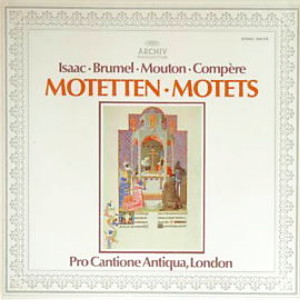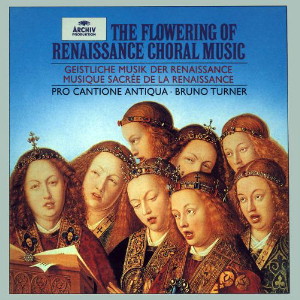 |
|
1 LP
- 2533 378 - (p) 1978
|
 |
| 7 CD's
- 445 667-2 - (c) 1994 |
|
| Geistliche Musik des 15. und
16. Jahrhunderts (Franko-Flämische
Schule) |
|
|
|
|
|
|
|
MOTETTEN - MOTETS
|
|
|
|
|
|
|
|
|
| Heinrich Isaac
(ca.1450-1517) |
|
|
|
|
| - Regina caeli
laetare - a 5 (AI-AII [mit
Zink] / TI-TII-B [mit Posaune] /
TIII mit Dulzian) |
Das Chorwerk
(No. 100), Wolfenbüttel 1965,
ed. M. Just |
|
5' 11" |
A1 |
| - O Maria,
mater Christi - a 4, a
cappella (A / TI / TII / B)
|
Das Chorwerk
(No. 100), Wolfenbüttel 1965,
ed. M. Just |
|
9' 23" |
A2 |
| - Quis dabit
capiti meo aquam - a 4, a
cappella (A / TI / TII / B) |
New York Pro
Musica Series No. 21, ed. N.
Greenberg, New York 1963 |
|
5' 48" |
A3 |
| - Tota pulchra
es - a 4, a cappella (A / TI
/ TII / B) |
Das Chorwerk
(No. 100), Wolfenbüttel 1965,
ed. M. Just |
|
7' 08" |
A4 |
|
|
|
|
|
| Antoine Brumel
(ca.1460 - ca.1520) |
|
|
|
|
| - O Domine
Jesu Christe - a 4 (TI mit
Zink / TII-BI [mit Posaune] / BII
mit Dulzian) |
Opera omnia,
ed. B. Hudson, = CMM 5 |
|
2' 47" |
B1 |
| - Noe noe
- a 4 (instrumental: Zink /
Posaune I-II / Dulzian |
Opera omnia,
ed. B. Hudson, = CMM 5 |
|
1' 11" |
B2 |
| - Ave virgo
gloriosa - a 4, a cappella
(A / TI / TII / B) |
Opera omnia,
ed. B. Hudson, = CMM 5 |
|
9' 53" |
B3 |
|
|
|
|
|
| Jean Mouton
(ca.1459-1522) |
|
|
|
|
| - Quaeramus
cum pastoribus - a 4, a
cappella (A / TI / TII / B) |
Unveröffentlicht:
für Pro Cantione Antiqua ed. von
Jeremy Noble (Quelle: London
Royal College of Music, Ms.
1070, verglichen mit "Tertia
pars magni operis musici",
Nürnberg 1559)
|
|
4' 20" |
B4 |
|
|
|
|
|
| Loyset Compère
(ca.1450-1518) |
|
|
|
|
| - Crux
triumphans - a 4, a cappella
(AI / TI / TII / B) |
Opera omnia,
ed. L. Finscher, = CMN 15 |
|
5' 28" |
B5 |
|
|
|
|
| PRO CANTIONE ANTIQUA, London |
THE LONDON
CORNETT AND SACKBUT ENSEMBLE |
| - Paul Esswood,
Kevin Smith, James Bowman, Counter-Tenor |
- Andrew van der
Beek, Zink und Dulzian |
| - James Griffett,
James Lewington, Ian Partridge, Tenor |
- Theresa Caudle,
Michael Laird, Zink |
| - Mark Brown,
Stephen Roberts, Brian Etheridge,
Ian Caddy, David Thomas, Paul
Elliott, Bass |
- Alan Lumsden,
Paul Nieman, Stephen Saunders, Posaune |
|
|
|
Bruno Turner,
Leitung |
|
|
|
|
Luogo
e data di registrazione |
|
Henry Wood
Hall, Trinity Church Square, London
(Inghilterra) - 16-21 febbraio 1977 |
|
|
Registrazione:
live / studio |
|
studio |
|
|
Production |
|
Dr. Andreas
Holschneider |
|
|
Recording
Supervision
|
|
Dr. Gerd
Ploebsch |
|
|
Recording
Engineer |
|
Hans-Peter
Schweigmann |
|
|
Prima
Edizione LP |
|
ARCHIV - 2533
378 - (1 LP - durata 51' 40") - (p) 1978 -
Analogico |
|
|
Prima
Edizione CD |
|
ARCHIV - 445
667-2 - (7 CD's - durata 72' 13", 65' 04",
78' 03", 75' 33", 53' 56", 77' 30" &
66' 38") - (c) 1994 - ADD
CD4 5-13
|
|
|
Cover |
|
"Die
Lreuzerhöhung - The Exaltation of the Holy
Cross - L'Exaltation de la sainte Croix",
Brüder Limburg, Les très riches heures de
Jean, Duc de Berry
Musée Condé, Chantilly - Ektachrome:
Giraudon, Paris |
|
|
|
|
The
music in this recording belongs to an
era which is conveniently but not very
aptly known as that of the
“Netherlanders”. This expression came
into use a century and a half ago on the
geographical basis of the nation at that
time termed the Netherlands; through all
the political changes since then the
expression “Netherlanders” has remained
in use, in the context of musical
history, even the alternative terms
suggested by scholars such as
“Franco-Flemish” have not been generally
adopted. By “Netherlanders” in this
sense are meant the many gifted
musicians who were produced during the
15th and 16th centuries by the area of
north-western Europe which now forms the
territories of Holland, Belgium and
northern France. Almost all of these
musicians, after years of training and
their first professional appointments at
cathedral choir schools in their native
land, found their way southwards, drawn
to - and not infrequently invited by -
the princely courts of Renaissance Italy
with their love of everything artistic.
This tendency to travel southward from
northern Europe gradually became so
pronounced from about the middle of the
15th century onward that the sources
reveal very little native Italian music,
and then usually only of a minor kind -
it was the Netherlanders who dominated
the development of European music at
that time. Not until the 16th century
were works of comparable significance
again produced by Italian composers.
All four of the masters represented in
this recording figure in musical history
as members of this group of
Netherlanders. All of them were born in
northern Europe about 1450, and they
probably all died between 1515 and 1525.
Every one of them went to Italy,
although Mouton spent only a short time
there. The closest links with the south
were those of the Flemish composer
Heinrich Isaac. Invited to Florence by
the Medici in 1484/85, unusually for one
of the Netherlanders he went to the
Hapsburg Court of the Emperor Maximilian
in 1496/97, but he did not entirely give
up his connection with Florence. Loyset
Compère, probably a native of St. Omer,
was active during the ’seventies at the
Sforza Court in Milan; later he is known
to have returned to the north, working
in Paris, Cambrai, Douai and St.
Quentin. Antoine Brumel, of whose early
career we have only sparse information
indicating appointments at Chartres,
Lâon, Faris and Lyons, went in 1505 as
director of music to the Este Court at
Ferrara. Only Jean Mouton remained
entirely true to his northern homeland:
born near Boulogne, he worked at Nesle,
Amiens and Grenoble, and from 1502
onward he was a member of the Royal
Court Chapel in Paris. A brief visit to
Bologna in 1516 appears to have been his
only stay in Italy.
····················
The motet had long been
unquestionably the most important type
of composition, but during the early
15th century settings of the Mass
gradually took precedence. The challenge
of fashioning the five sections of the
Ordinary of the Mass into a musically
unified cycle seems to have fired the
artistic ambitions of composers to an
even greater extent than the problems of
Writing motets, with the result that the
motet exerted less fascination than the
Mass, and it did not regain first-rank
importance until the 16th century.
Nevertheless anyone who explores the
motets of the period discovers
everywhere a wealth of splendid and
masterly music. In a certain sense the
composition of a motet offered greater
scope for imaginative creative work than
a setting of the Mass: it was not based
on a pre-determined text, and could even
make use of secular elements - a fact
which naturally had its effcct on the
diversity of music being composed. A
motet could be intended for a particular
event of the Church year, but it could
also owe its existence to contemporary
events. This is so in the case of
Isaac’s funeral motet Quis dabit
capiti meo aquam; in the words of
this piece the humanist Angelo Poliziano
mourns Lorenzo il Magnifico, who had
been killed by lightning (in April
1492). There is no indication from a
hearing of this motet that Isaac,
possibly because he was pressed for
time, took considerable sections of this
motet from his Mass “Salva nos” and
linked them by means of new transitional
passages; the composition is skilfully
fashioned round a kind of “axis”,
consisting of ostinato repetition,
generally in a lower part, of the
concluding phrase “et requiescamus in
pace” from the antiphon “Salva nos”.
While the fullness of sound,
particularly at the beginnings of
sections, with rich chordal writing,
possibly points to a stylistic feature
of Italian music, the other three
motets, which date from Isaac’s time in
Germany, are predominantly contrapuntal
works. Use is made in each of them of a
plainsong or semiliturgical melody,
though these are employed in different
ways: in the motet to words from the
Song of Songs Tota pulchra est,
composed about 1500/5, the plainsong
melody appears in the treble or tenor,
and sometimes pseudo-canonically in both
parts. In Regina caeli laetare,
written a few years later, the
pseudo-canonic cantus firmus, sung in
long-held notes by the lower voices,
continues even more persistently; the
characteristics of this plainsong melody
also permeate the more animated upper
voices, and each section of the piece
leads beautifully into a lively Alleluia
conclusion. In the motet O Maria,
mater Christi, probably one of his
late works, Isaac made use of the cantus
firmus and canonic techniques already
mentioned, and also inserted duet
sections into the structure; recurring
melodic figures and the reappearance at
the conclusion of material presented at
the beginning give the composition a
remarkable sense of unity.
The prayerful motet O Domine Jesu
Christe by Brumel is particularly
attractive because of its unusually low
setting and the masterly way he
organizes the different parts. Its
tendency towards chordal writing is
emphasized when it is followed by the
wordless instrumental piece Noe noe
which, especially in its second half,
shows Brumel to have been a master of
sequences of brief motives which are
contrapuntally interwoven. Finally
Brumel’s large-scale motet Ave virgo
gloriosa is marked by a skilful
combination of chordal and figural
writing; here, too, passages of bicinia
occur between sections for the full
ensemble. Mouton’s Christmas motet Quaeramus
cum pastoribus, in which animated
sections for few voices provide contrast
with the rich choral texture elsewhere
in the work, is followed by Compère’s
Passion composition Crux triumphans;
as in the works of Brumel no plainsong
melody is used here, and Compère, too,
understood how to alternate rich chordal
sections with those based on figuration,
here making little use of imitation.
Especially expressive are the
acclamations “Jesus” which occur several
times during the second section of the
motet. If there is any need for proof of
the richness of the wonderful artistry
displayed in the motets of the
Netherlands masters, the examples by
Isaac, Brumel, Mouton and Compère
brought together here make this proof
convincing in terms of actual sound.
Martin
Staehelin
Translator: John Coombs
|
|
|

